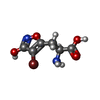[English] 日本語
 Yorodumi
Yorodumi- PDB-1m5d: X-RAY STRUCTURE OF THE GLUR2 LIGAND BINDING CORE (S1S2J-Y702F) IN... -
+ Open data
Open data
- Basic information
Basic information
| Entry | Database: PDB / ID: 1m5d | ||||||
|---|---|---|---|---|---|---|---|
| Title | X-RAY STRUCTURE OF THE GLUR2 LIGAND BINDING CORE (S1S2J-Y702F) IN COMPLEX WITH Br-HIBO AT 1.73 A RESOLUTION | ||||||
 Components Components | Glutamate receptor 2 GRIA2 GRIA2 | ||||||
 Keywords Keywords |  MEMBRANE PROTEIN / MEMBRANE PROTEIN /  Ionotropic glutamate receptor / Ionotropic glutamate receptor /  GluR2 / ligand binding core / GluR2 / ligand binding core /  agonist complex agonist complex | ||||||
| Function / homology |  Function and homology information Function and homology informationspine synapse / dendritic spine neck / dendritic spine head / Activation of AMPA receptors / response to lithium ion / perisynaptic space / cellular response to glycine / AMPA glutamate receptor activity / Trafficking of GluR2-containing AMPA receptors /  immunoglobulin binding ...spine synapse / dendritic spine neck / dendritic spine head / Activation of AMPA receptors / response to lithium ion / perisynaptic space / cellular response to glycine / AMPA glutamate receptor activity / Trafficking of GluR2-containing AMPA receptors / immunoglobulin binding ...spine synapse / dendritic spine neck / dendritic spine head / Activation of AMPA receptors / response to lithium ion / perisynaptic space / cellular response to glycine / AMPA glutamate receptor activity / Trafficking of GluR2-containing AMPA receptors /  immunoglobulin binding / AMPA glutamate receptor complex / kainate selective glutamate receptor activity / immunoglobulin binding / AMPA glutamate receptor complex / kainate selective glutamate receptor activity /  ionotropic glutamate receptor complex / extracellularly glutamate-gated ion channel activity / asymmetric synapse / regulation of receptor recycling / Unblocking of NMDA receptors, glutamate binding and activation / ionotropic glutamate receptor complex / extracellularly glutamate-gated ion channel activity / asymmetric synapse / regulation of receptor recycling / Unblocking of NMDA receptors, glutamate binding and activation /  glutamate receptor binding / positive regulation of synaptic transmission / glutamate-gated receptor activity / presynaptic active zone membrane / response to fungicide / glutamate receptor binding / positive regulation of synaptic transmission / glutamate-gated receptor activity / presynaptic active zone membrane / response to fungicide /  regulation of synaptic transmission, glutamatergic / cellular response to brain-derived neurotrophic factor stimulus / somatodendritic compartment / dendrite membrane / ligand-gated monoatomic ion channel activity involved in regulation of presynaptic membrane potential / regulation of synaptic transmission, glutamatergic / cellular response to brain-derived neurotrophic factor stimulus / somatodendritic compartment / dendrite membrane / ligand-gated monoatomic ion channel activity involved in regulation of presynaptic membrane potential /  ionotropic glutamate receptor binding / ionotropic glutamate receptor signaling pathway / dendrite cytoplasm / ionotropic glutamate receptor binding / ionotropic glutamate receptor signaling pathway / dendrite cytoplasm /  cytoskeletal protein binding / cytoskeletal protein binding /  SNARE binding / transmitter-gated monoatomic ion channel activity involved in regulation of postsynaptic membrane potential / dendritic shaft / SNARE binding / transmitter-gated monoatomic ion channel activity involved in regulation of postsynaptic membrane potential / dendritic shaft /  synaptic membrane / synaptic membrane /  synaptic transmission, glutamatergic / synaptic transmission, glutamatergic /  PDZ domain binding / postsynaptic density membrane / protein tetramerization / modulation of chemical synaptic transmission / Schaffer collateral - CA1 synapse / establishment of protein localization / PDZ domain binding / postsynaptic density membrane / protein tetramerization / modulation of chemical synaptic transmission / Schaffer collateral - CA1 synapse / establishment of protein localization /  terminal bouton / terminal bouton /  receptor internalization / synaptic vesicle membrane / cerebral cortex development / receptor internalization / synaptic vesicle membrane / cerebral cortex development /  synaptic vesicle / presynapse / synaptic vesicle / presynapse /  signaling receptor activity / signaling receptor activity /  presynaptic membrane / presynaptic membrane /  amyloid-beta binding / amyloid-beta binding /  growth cone / growth cone /  perikaryon / chemical synaptic transmission / perikaryon / chemical synaptic transmission /  scaffold protein binding / scaffold protein binding /  postsynaptic membrane / postsynaptic membrane /  dendritic spine / dendritic spine /  postsynaptic density / neuron projection / postsynaptic density / neuron projection /  axon / neuronal cell body / axon / neuronal cell body /  dendrite / dendrite /  synapse / glutamatergic synapse / protein-containing complex binding / endoplasmic reticulum membrane / synapse / glutamatergic synapse / protein-containing complex binding / endoplasmic reticulum membrane /  protein kinase binding / protein kinase binding /  cell surface / cell surface /  endoplasmic reticulum / protein-containing complex / endoplasmic reticulum / protein-containing complex /  membrane / identical protein binding / membrane / identical protein binding /  plasma membrane plasma membraneSimilarity search - Function | ||||||
| Biological species |   Rattus norvegicus (Norway rat) Rattus norvegicus (Norway rat) | ||||||
| Method |  X-RAY DIFFRACTION / X-RAY DIFFRACTION /  SYNCHROTRON / Difference Fourier / Resolution: 1.73 Å SYNCHROTRON / Difference Fourier / Resolution: 1.73 Å | ||||||
 Authors Authors | Hogner, A. / Kastrup, J.S. / Jin, R. / Liljefors, T. / Mayer, M.L. / Egebjerg, J. / Larsen, I.K. / Gouaux, E. | ||||||
 Citation Citation |  Journal: J.Mol.Biol. / Year: 2002 Journal: J.Mol.Biol. / Year: 2002Title: Structural Basis for AMPA Receptor Activation and Ligand Selectivity: Crystal Structures of Five Agonist Complexes with the GluR2 Ligand-binding Core Authors: Hogner, A. / Kastrup, J.S. / Jin, R. / Liljefors, T. / Mayer, M.L. / Egebjerg, J. / Larsen, I.K. / Gouaux, E. #1:  Journal: Neuron / Year: 2000 Journal: Neuron / Year: 2000Title: Mechanisms for activation and antagonism of an AMPA-sensitive glutamate receptor: Crystal structures of the GluR2 ligand binding core. Authors: Armstrong, N. / Gouaux, E. #2:  Journal: Nature / Year: 2002 Journal: Nature / Year: 2002Title: Mechanism of glutamate receptor desensitization. Authors: Sun, Y. / Olson, R. / Horning, M. / Armstrong, N. / Mayer, M. / Gouaux, E. #3:  Journal: Protein Sci. / Year: 1998 Journal: Protein Sci. / Year: 1998Title: Probing the ligand binding domain of the GluR2 receptor by proteolysis and deletion mutagenesis defines domain boundaries and yields a crystallizable construct. Authors: Chen, G.Q. / Sun, Y. / Jin, R. / Gouaux, E. | ||||||
| History |
| ||||||
| Remark 999 | Sequence Native GluR2 is a membrane protein. The protein crystallized is the extracellular ligand ...Sequence Native GluR2 is a membrane protein. The protein crystallized is the extracellular ligand binding domain of GluR2. Transmembrane regions were genetically removed and replaced with a GLY-THR linker (residues 118 and 119). Therefore, the sequence matches discontinuously with the reference database (413-527, 653-796). Residues GLY1 and ALA2 are cloning artifacts. The engineered mutation is listed by the author as Y702F which corresponds to Y723F in the database sequence. The author numbered the sequence according to the predicted mature GluR2 sequence. Therefore, the signal sequence (residues 1-21) are not included in the author's sequence numbering. |
- Structure visualization
Structure visualization
| Structure viewer | Molecule:  Molmil Molmil Jmol/JSmol Jmol/JSmol |
|---|
- Downloads & links
Downloads & links
- Download
Download
| PDBx/mmCIF format |  1m5d.cif.gz 1m5d.cif.gz | 69.9 KB | Display |  PDBx/mmCIF format PDBx/mmCIF format |
|---|---|---|---|---|
| PDB format |  pdb1m5d.ent.gz pdb1m5d.ent.gz | 54.4 KB | Display |  PDB format PDB format |
| PDBx/mmJSON format |  1m5d.json.gz 1m5d.json.gz | Tree view |  PDBx/mmJSON format PDBx/mmJSON format | |
| Others |  Other downloads Other downloads |
-Validation report
| Arichive directory |  https://data.pdbj.org/pub/pdb/validation_reports/m5/1m5d https://data.pdbj.org/pub/pdb/validation_reports/m5/1m5d ftp://data.pdbj.org/pub/pdb/validation_reports/m5/1m5d ftp://data.pdbj.org/pub/pdb/validation_reports/m5/1m5d | HTTPS FTP |
|---|
-Related structure data
| Related structure data |  1m5bC  1m5cSC 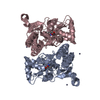 1m5eC  1m5fC C: citing same article ( S: Starting model for refinement |
|---|---|
| Similar structure data |
- Links
Links
- Assembly
Assembly
| Deposited unit | 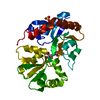
| |||||||||
|---|---|---|---|---|---|---|---|---|---|---|
| 1 | 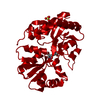
| |||||||||
| Unit cell |
| |||||||||
| Components on special symmetry positions |
| |||||||||
| Details | The biological assembly is a dimer. The dimer of chain A can be generated by the two fold axis: -x, -y, z. |
- Components
Components
| #1: Protein |  GRIA2 / GLUR-2 / GLUR-B / GLUR-K2 / GLUTAMATE RECEPTOR IONOTROPIC AMPA 2 GRIA2 / GLUR-2 / GLUR-B / GLUR-K2 / GLUTAMATE RECEPTOR IONOTROPIC AMPA 2Mass: 29205.682 Da / Num. of mol.: 1 / Fragment: flop ligand binding core (S1S2J-Y702F) / Mutation: Y190F Source method: isolated from a genetically manipulated source Source: (gene. exp.)   Rattus norvegicus (Norway rat) / Gene: GluR-2 / Plasmid: pET30B / Species (production host): Escherichia coli / Production host: Rattus norvegicus (Norway rat) / Gene: GluR-2 / Plasmid: pET30B / Species (production host): Escherichia coli / Production host:   Escherichia coli BL21(DE3) (bacteria) / Strain (production host): BL21(DE3) / References: UniProt: P19491 Escherichia coli BL21(DE3) (bacteria) / Strain (production host): BL21(DE3) / References: UniProt: P19491 | ||||
|---|---|---|---|---|---|
| #2: Chemical |  Sulfate Sulfate#3: Chemical | ChemComp-BRH / ( | #4: Water | ChemComp-HOH / |  Water Water |
-Experimental details
-Experiment
| Experiment | Method:  X-RAY DIFFRACTION / Number of used crystals: 1 X-RAY DIFFRACTION / Number of used crystals: 1 |
|---|
- Sample preparation
Sample preparation
| Crystal | Density Matthews: 2.28 Å3/Da / Density % sol: 45.96 % | |||||||||||||||||||||||||||||||||||||||||||||||||||||||||||||||
|---|---|---|---|---|---|---|---|---|---|---|---|---|---|---|---|---|---|---|---|---|---|---|---|---|---|---|---|---|---|---|---|---|---|---|---|---|---|---|---|---|---|---|---|---|---|---|---|---|---|---|---|---|---|---|---|---|---|---|---|---|---|---|---|---|
Crystal grow | Temperature: 279 K / Method: vapor diffusion, hanging drop / pH: 4.5 Details: PEG 3350, Li2SO4, phosphate-citrate, pH 4.5, VAPOR DIFFUSION, HANGING DROP, temperature 279K | |||||||||||||||||||||||||||||||||||||||||||||||||||||||||||||||
| Crystal grow | *PLUS Temperature: 4 ℃ / pH: 7 | |||||||||||||||||||||||||||||||||||||||||||||||||||||||||||||||
| Components of the solutions | *PLUS
|
-Data collection
| Diffraction | Mean temperature: 110 K |
|---|---|
| Diffraction source | Source:  SYNCHROTRON / Site: SYNCHROTRON / Site:  EMBL/DESY, HAMBURG EMBL/DESY, HAMBURG  / Beamline: X13 / Wavelength: 0.802 Å / Beamline: X13 / Wavelength: 0.802 Å |
| Detector | Type: MARRESEARCH / Detector: CCD / Date: Aug 15, 2001 |
| Radiation | Protocol: SINGLE WAVELENGTH / Monochromatic (M) / Laue (L): M / Scattering type: x-ray |
| Radiation wavelength | Wavelength : 0.802 Å / Relative weight: 1 : 0.802 Å / Relative weight: 1 |
| Reflection | Resolution: 1.73→20 Å / Num. all: 27834 / Num. obs: 27589 / % possible obs: 97.9 % / Observed criterion σ(I): -3 / Redundancy: 4.8 % / Biso Wilson estimate: 20.9 Å2 / Rmerge(I) obs: 0.072 / Net I/σ(I): 14.3 |
| Reflection shell | Resolution: 1.73→1.77 Å / Rmerge(I) obs: 0.393 / Mean I/σ(I) obs: 4 / Num. unique all: 1829 / % possible all: 97.4 |
| Reflection | *PLUS Lowest resolution: 20 Å / Num. obs: 27834 |
| Reflection shell | *PLUS % possible obs: 97.4 % |
- Processing
Processing
| Software |
| ||||||||||||||||||||||||||||||||||||
|---|---|---|---|---|---|---|---|---|---|---|---|---|---|---|---|---|---|---|---|---|---|---|---|---|---|---|---|---|---|---|---|---|---|---|---|---|---|
| Refinement | Method to determine structure : Difference Fourier : Difference FourierStarting model: PDB entry 1M5C (S1S2J:Br-HIBO). Resolution: 1.73→19.59 Å / Rfactor Rfree error: 0.006 / Data cutoff high absF: 1249977 / Data cutoff high rms absF: 1249977 / Isotropic thermal model: RESTRAINED / Cross valid method: THROUGHOUT / σ(F): 0 / Stereochemistry target values: Engh & Huber Details: Residues 1-3 and 262-263 were not located in the electron density map. The side chains of the following residues are not fully defined: LYS A4, LYS A21, LYS A50, LYS A69, ARG A172, LYS A258
| ||||||||||||||||||||||||||||||||||||
| Solvent computation | Solvent model: FLAT MODEL / Bsol: 63.7557 Å2 / ksol: 0.445437 e/Å3 | ||||||||||||||||||||||||||||||||||||
| Displacement parameters | Biso mean: 24.2 Å2
| ||||||||||||||||||||||||||||||||||||
| Refine analyze |
| ||||||||||||||||||||||||||||||||||||
| Refinement step | Cycle: LAST / Resolution: 1.73→19.59 Å
| ||||||||||||||||||||||||||||||||||||
| Refine LS restraints |
| ||||||||||||||||||||||||||||||||||||
| LS refinement shell | Resolution: 1.73→1.84 Å / Rfactor Rfree error: 0.018 / Total num. of bins used: 6
| ||||||||||||||||||||||||||||||||||||
| Xplor file | Serial no: 1 / Param file: PROTEIN_REP.PARAM / Topol file: PROTEIN.TOP | ||||||||||||||||||||||||||||||||||||
| Refinement | *PLUS Lowest resolution: 20 Å / % reflection Rfree: 5 % / Rfactor Rfree : 0.214 : 0.214 | ||||||||||||||||||||||||||||||||||||
| Solvent computation | *PLUS | ||||||||||||||||||||||||||||||||||||
| Displacement parameters | *PLUS | ||||||||||||||||||||||||||||||||||||
| Refine LS restraints | *PLUS
|
 Movie
Movie Controller
Controller


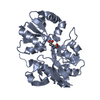


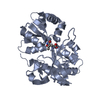
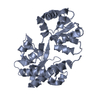
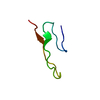

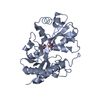
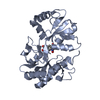

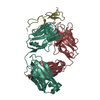

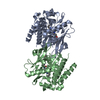

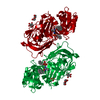
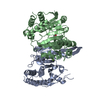
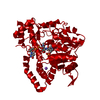
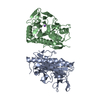

 PDBj
PDBj







